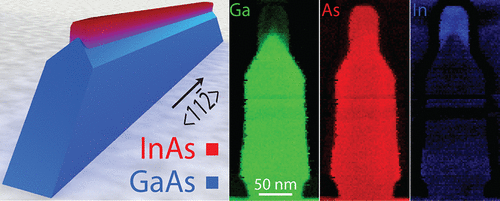当前位置:
X-MOL 学术
›
Nano Lett.
›
论文详情
Our official English website, www.x-mol.net, welcomes your feedback! (Note: you will need to create a separate account there.)
Template-Assisted Scalable Nanowire Networks
Nano Letters ( IF 10.8 ) Pub Date : 2018-03-26 00:00:00 , DOI: 10.1021/acs.nanolett.8b00554 Martin Friedl 1 , Kris Cerveny 2 , Pirmin Weigele 2 , Gozde Tütüncüoglu 1 , Sara Martí-Sánchez 3 , Chunyi Huang 4 , Taras Patlatiuk 2 , Heidi Potts 1 , Zhiyuan Sun 4 , Megan O. Hill 4 , Lucas Güniat 1 , Wonjong Kim 1 , Mahdi Zamani 1 , Vladimir G. Dubrovskii 5 , Jordi Arbiol 3, 6 , Lincoln J. Lauhon 4 , Dominik M. Zumbühl 2 , Anna Fontcuberta i Morral 1
Nano Letters ( IF 10.8 ) Pub Date : 2018-03-26 00:00:00 , DOI: 10.1021/acs.nanolett.8b00554 Martin Friedl 1 , Kris Cerveny 2 , Pirmin Weigele 2 , Gozde Tütüncüoglu 1 , Sara Martí-Sánchez 3 , Chunyi Huang 4 , Taras Patlatiuk 2 , Heidi Potts 1 , Zhiyuan Sun 4 , Megan O. Hill 4 , Lucas Güniat 1 , Wonjong Kim 1 , Mahdi Zamani 1 , Vladimir G. Dubrovskii 5 , Jordi Arbiol 3, 6 , Lincoln J. Lauhon 4 , Dominik M. Zumbühl 2 , Anna Fontcuberta i Morral 1
Affiliation

|
Topological qubits based on Majorana Fermions have the potential to revolutionize the emerging field of quantum computing by making information processing significantly more robust to decoherence. Nanowires are a promising medium for hosting these kinds of qubits, though branched nanowires are needed to perform qubit manipulations. Here we report a gold-free templated growth of III–V nanowires by molecular beam epitaxy using an approach that enables patternable and highly regular branched nanowire arrays on a far greater scale than what has been reported thus far. Our approach relies on the lattice-mismatched growth of InAs on top of defect-free GaAs nanomembranes yielding laterally oriented, low-defect InAs and InGaAs nanowires whose shapes are determined by surface and strain energy minimization. By controlling nanomembrane width and growth time, we demonstrate the formation of compositionally graded nanowires with cross-sections less than 50 nm. Scaling the nanowires below 20 nm leads to the formation of homogeneous InGaAs nanowires, which exhibit phase-coherent, quasi-1D quantum transport as shown by magnetoconductance measurements. These results are an important advance toward scalable topological quantum computing.
中文翻译:

模板辅助的可扩展纳米线网络
基于马里亚纳费米子的拓扑量子位通过使信息处理对去相干性的鲁棒性大大增强,从而有可能彻底改变新兴的量子计算领域。纳米线是承载这类量子位的有前途的媒介,尽管需要分支的纳米线来执行量子位操作。在这里,我们报告了通过分子束外延技术使用的无金模板生长的III-V纳米线,该方法可实现比迄今为止已报道的规模更大的可图案化和高度规则的分支纳米线阵列。我们的方法依赖于无缺陷的GaAs纳米膜之上的InAs晶格失配生长,从而产生横向取向,低缺陷的InAs和InGaAs纳米线,其形状由表面和应变能最小化确定。通过控制纳米膜的宽度和生长时间,我们证明了截面小于50 nm的成分渐变纳米线的形成。将纳米线缩放到20 nm以下会导致形成均质的InGaAs纳米线,该纳米线表现出相干,准1D量子传输,如磁导测量所示。这些结果是朝可伸缩拓扑量子计算迈出的重要一步。
更新日期:2018-03-26
中文翻译:

模板辅助的可扩展纳米线网络
基于马里亚纳费米子的拓扑量子位通过使信息处理对去相干性的鲁棒性大大增强,从而有可能彻底改变新兴的量子计算领域。纳米线是承载这类量子位的有前途的媒介,尽管需要分支的纳米线来执行量子位操作。在这里,我们报告了通过分子束外延技术使用的无金模板生长的III-V纳米线,该方法可实现比迄今为止已报道的规模更大的可图案化和高度规则的分支纳米线阵列。我们的方法依赖于无缺陷的GaAs纳米膜之上的InAs晶格失配生长,从而产生横向取向,低缺陷的InAs和InGaAs纳米线,其形状由表面和应变能最小化确定。通过控制纳米膜的宽度和生长时间,我们证明了截面小于50 nm的成分渐变纳米线的形成。将纳米线缩放到20 nm以下会导致形成均质的InGaAs纳米线,该纳米线表现出相干,准1D量子传输,如磁导测量所示。这些结果是朝可伸缩拓扑量子计算迈出的重要一步。



























 京公网安备 11010802027423号
京公网安备 11010802027423号